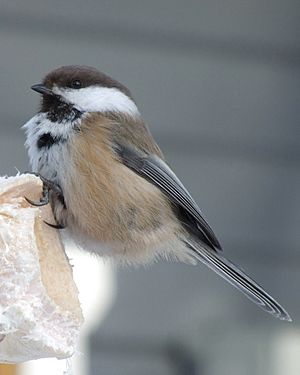Grey-headed chickadee facts for kids
Quick facts for kids Grey-headed chickadee |
|
|---|---|
 |
|
| Conservation status | |
| Scientific classification | |
| Genus: |
Poecile
|
| Species: |
cinctus
|
 |
|
| Range of Poecile cinctus | |
| Synonyms | |
|
Parus cinctus |
|
The grey-headed chickadee is also known as the Siberian tit. Its scientific name is Poecile cinctus. This small bird belongs to the tit family. It lives in many cold, northern parts of the world. You can find it in subarctic Scandinavia, northern Palearctic regions, Alaska, and northwest Canada.
This bird loves conifer forests. It usually stays in one place and does not migrate far. Even though it's called "grey-headed," its head is actually black, white, and brown. It does not have any grey!
The grey-headed chickadee is a medium-sized tit. It is about 13.5 to 14 centimeters (5.3 to 5.5 inches) long. It weighs between 11 and 14.3 grams (0.39 to 0.50 ounces). Its head is dark brown with white cheeks. Its back is brown, and its wing feathers are blackish with light edges. The underside of its body is whitish with light brown sides.
Where It Lives and Why It's Changing
Scientists in Folldal, Norway, studied these birds. They found that the number of Siberian tits in pine forests dropped a lot. In 1982, they made up 64% of all tits. But by 2011, they were only 1%.
This big drop happened for a few reasons. One reason is competition with other birds. The willow tit and great tit might be taking over their space. Another reason is climate change. This has caused less plant life in their habitat. Also, people are cutting down old-growth trees. These old trees are what the grey-headed chickadees prefer for their homes.
How Scientists Name Birds
The grey-headed chickadee was first described in 1779. A French scientist named Georges-Louis Leclerc, Comte de Buffon wrote about it. He saw a bird from Siberia. Later, in 1783, a Dutch scientist named Pieter Boddaert gave it a scientific name. He called it Parus cinctus.
Today, the grey-headed chickadee is in a group of 15 species. This group is called the genus Poecile. A German scientist, Johann Jakob Kaup, created this group in 1829. The name Poecile comes from an old Greek word meaning "colorful." The second part of its name, cinctus, is Latin for "banded."
Scientists used to put the grey-headed chickadee in the Parus group. But new studies of their DNA showed that Poecile is a better fit. This helps us understand how these birds are related to each other.
There are four different types, or subspecies, of the grey-headed chickadee:
- P. c. lapponicus (Lundahl, 1848) – Found from Scandinavia to northern European Russia.
- P. c. cinctus (Boddaert, 1783) – Lives from northeast European Russia through Siberia to Kamchatka and north central Mongolia.
- P. c. sayanus Sushkin, 1904 – Found in south Siberia and northwest Mongolia.
- P. c. lathami (Stephens, 1817) – Lives in northern and western Alaska and northwest Canada.
Images for kids
See also
 In Spanish: Carbonero lapón para niños
In Spanish: Carbonero lapón para niños



